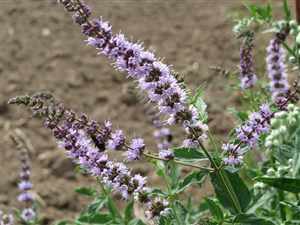Spearmint (Mentha spicata)
Main Facts about Spearmint

Using Spearmint
A tea made from the leaves has traditionally been used in the treatment of fevers, headaches, digestive disorders and various minor ailments. The herb is antispasmodic, urine-inducing, restorative, stimulant, and has agents that prevent vomiting, relieve and remove gas from the digestive system, and give tone and strength to the stomach. Helps stop vomiting during pregnancy. Gentle colic relief for babies. It is used to calm nerves, stress, cramps. Both the essential oil and the stems are used in folk remedies for cancer. A poultice prepared from the leaves is said to remedy tumours. The oil is used commercially as a flavoring for toothpaste and confectionery, and is sometimes added to shampoos and soaps. The plant repels insects, rats, and mice.Spearmint is a remedy for: Anxiety
Cooking with Spearmint
The leaves of spearmint are edible raw or cooked. Having a strong spearmint flavor, they are used as a flavoring in salads or cooked foods. Spearmint leaves can be used whole, chopped, dried and ground, frozen, preserved in salt, sugar, sugar syrup, alcohol, oil. The leaves are often used in 'mint sauce', which is used as a flavoring in meals. A herb tea is made from the fresh or dried leaves. It has a very pleasant and refreshing taste of spearmint, leaving the mouth and digestive system feeling clean. An essential oil from the leaves and flowers is used as a flavoring in sweets, ice cream, drinks etc.How to grow Spearmint
Found growing on roadsides and in waste places, usually in damp soils and sunny positions. Cultivation: Spearmint is easily grown, it succeeds in most soils and situations so long as the soil is not too dry. Prefers a sunny position for production of essential oils, but it also succeeds in partial shade. Division can be easily done at almost any time of the year. Can be invasive, so restrict root run.| Snapdragon |
St. John's wort
|